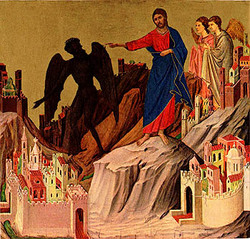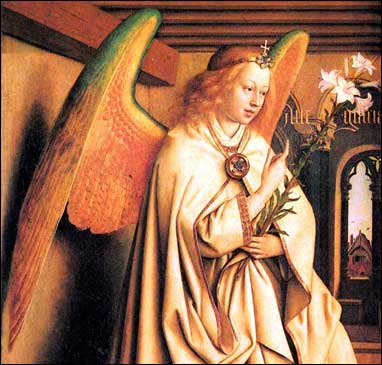Today [March 1st] is the First Sunday of Lent, and the Gospel, with the sober and concise style of St. Mark, introduces us to the climate of this liturgical season: "The Spirit drove Jesus out into the desert, and he remained in the desert for 40 days, tempted by Satan" (Mark 1:12). In the Holy Land, west of the Jordan and the oasis of Jericho, there is the desert of Judah, which ascends to a height of over 1,000 meters through rocky valleys, stretching all the way to Jerusalem.
 After having received baptism from John, Jesus enters that empty place, led by the Holy Spirit himself, which had descended upon him, consecrating him and revealing him as the Son of God. In the desert, the place of trial -- as the experience of the people of Israel shows -- there appears the dramatic reality of the "kenosis," the emptying of Christ, who is stripped of the form of God (cf. Philippians 2:6-7). He, who did not sin and cannot sin, submits himself to trial and thus can have compassion for our infirmities (cf. Hebrews 4:15). He lets himself be tempted by Satan, the adversary, who had opposed himself to God's salvific plan for men from the very beginning.
After having received baptism from John, Jesus enters that empty place, led by the Holy Spirit himself, which had descended upon him, consecrating him and revealing him as the Son of God. In the desert, the place of trial -- as the experience of the people of Israel shows -- there appears the dramatic reality of the "kenosis," the emptying of Christ, who is stripped of the form of God (cf. Philippians 2:6-7). He, who did not sin and cannot sin, submits himself to trial and thus can have compassion for our infirmities (cf. Hebrews 4:15). He lets himself be tempted by Satan, the adversary, who had opposed himself to God's salvific plan for men from the very beginning.
In the brevity of the account, in the face of this obscure and darksome figure who dares to
 tempt the Lord, the angels, luminous and mysterious figures, fleetingly appear. The Gospel says that the angels "serve" Jesus (Mark 1:13); they are the counterpoint to Satan. "Angel" means "one who is sent." We find these figures throughout the Old Testament who help and guide men in the name of God. Just consider the Book of Tobit, in which the figure of the angel Raphael appears to assist the protagonist through many vicissitudes. The reassuring presence of the angel of the Lord accompanies the people of Israel through every event, good and bad. On the threshold of the New Testament, Gabriel is sent to announce to Zachariah and Mary the joyous happenings that are the beginnings of our salvation; and an angel, whose name is not mentioned, warns Joseph, directing him in that moment of uncertainty. A chorus of angels reports the glad tidings of Jesus' birth to the shepherds, as the glad tidings of his resurrection will also be announced by angels to the women. At the end of time the angels will accompany Jesus in his glorious return (cf. Matthew 25:31).
tempt the Lord, the angels, luminous and mysterious figures, fleetingly appear. The Gospel says that the angels "serve" Jesus (Mark 1:13); they are the counterpoint to Satan. "Angel" means "one who is sent." We find these figures throughout the Old Testament who help and guide men in the name of God. Just consider the Book of Tobit, in which the figure of the angel Raphael appears to assist the protagonist through many vicissitudes. The reassuring presence of the angel of the Lord accompanies the people of Israel through every event, good and bad. On the threshold of the New Testament, Gabriel is sent to announce to Zachariah and Mary the joyous happenings that are the beginnings of our salvation; and an angel, whose name is not mentioned, warns Joseph, directing him in that moment of uncertainty. A chorus of angels reports the glad tidings of Jesus' birth to the shepherds, as the glad tidings of his resurrection will also be announced by angels to the women. At the end of time the angels will accompany Jesus in his glorious return (cf. Matthew 25:31).
The angels serve Jesus, who is certainly superior to them, and this dignity of his is proclaimed in a clear though discreet way here in the Gospel. Indeed, even in the situation of extreme poverty and humility, when he is tempted by Satan, he remains the Son of God, the Messiah, the Lord.
 Dear brothers and sisters, we would take away a significant part of the Gospel if we left aside these beings sent by God to announce his presence among us and be a sign of that presence. Let us call upon them often, that they sustain us in the task of following Jesus to the point of identifying ourselves with him. Let us ask them, especially today, to watch over me and my co-workers in the Roman Curia as we begin our retreat this week, as we do every year. Mary, Queen of Angels, pray for us!
Dear brothers and sisters, we would take away a significant part of the Gospel if we left aside these beings sent by God to announce his presence among us and be a sign of that presence. Let us call upon them often, that they sustain us in the task of following Jesus to the point of identifying ourselves with him. Let us ask them, especially today, to watch over me and my co-workers in the Roman Curia as we begin our retreat this week, as we do every year. Mary, Queen of Angels, pray for us!
Pope Benedict XVI
1 March 2009, First Sunday of Lent
St Peter's Square
PS: You may want to read the booklet, "All About Angels" published by the Catholic Information Service.




